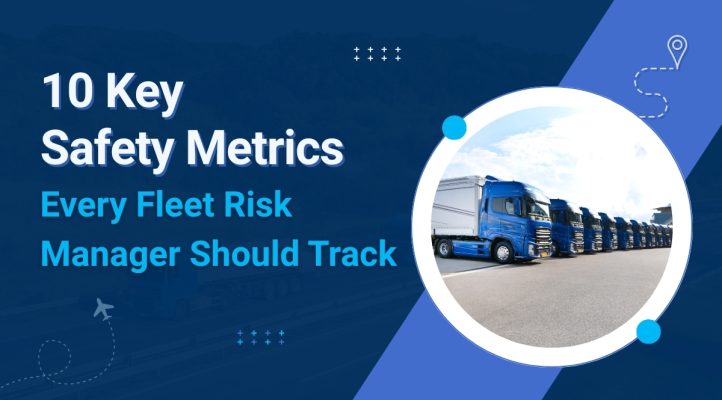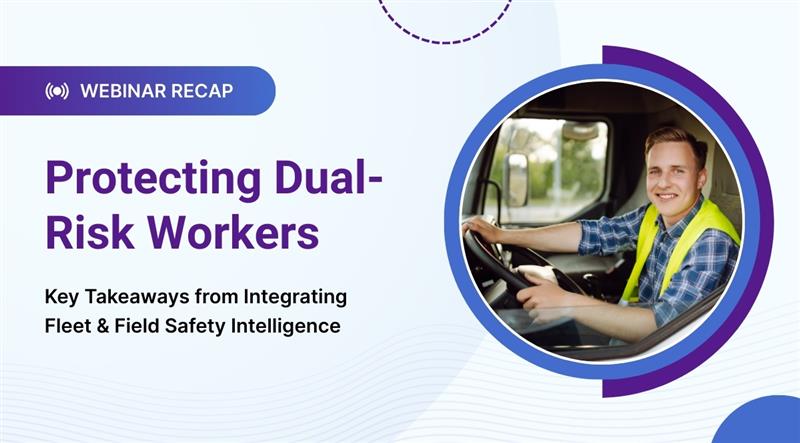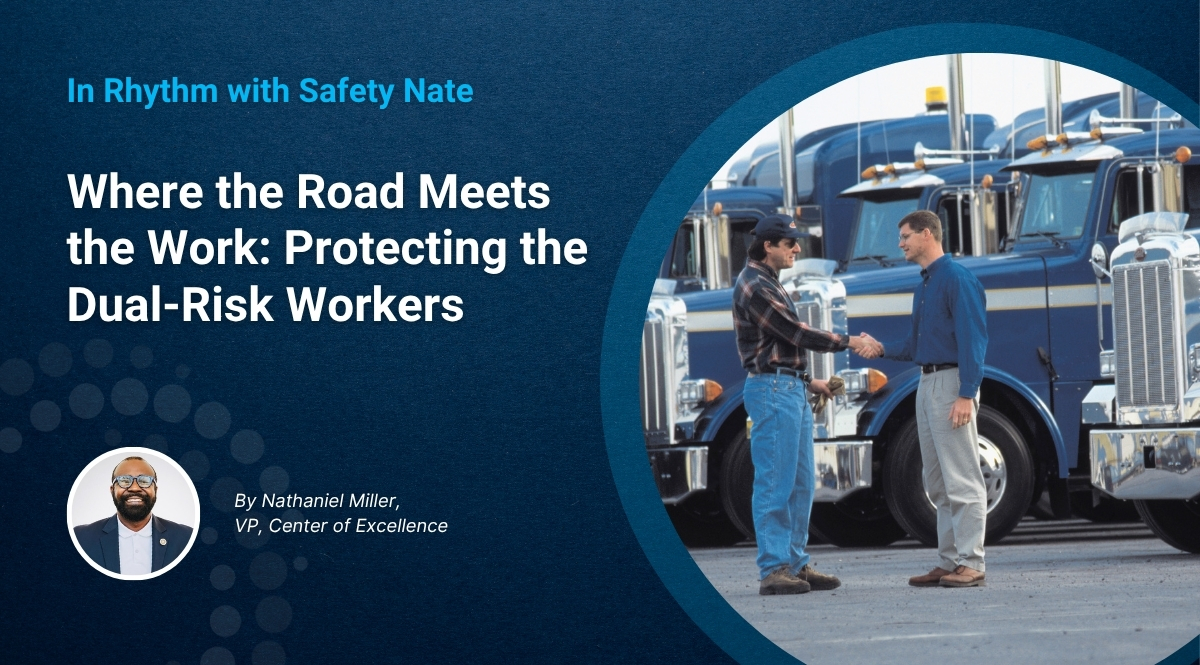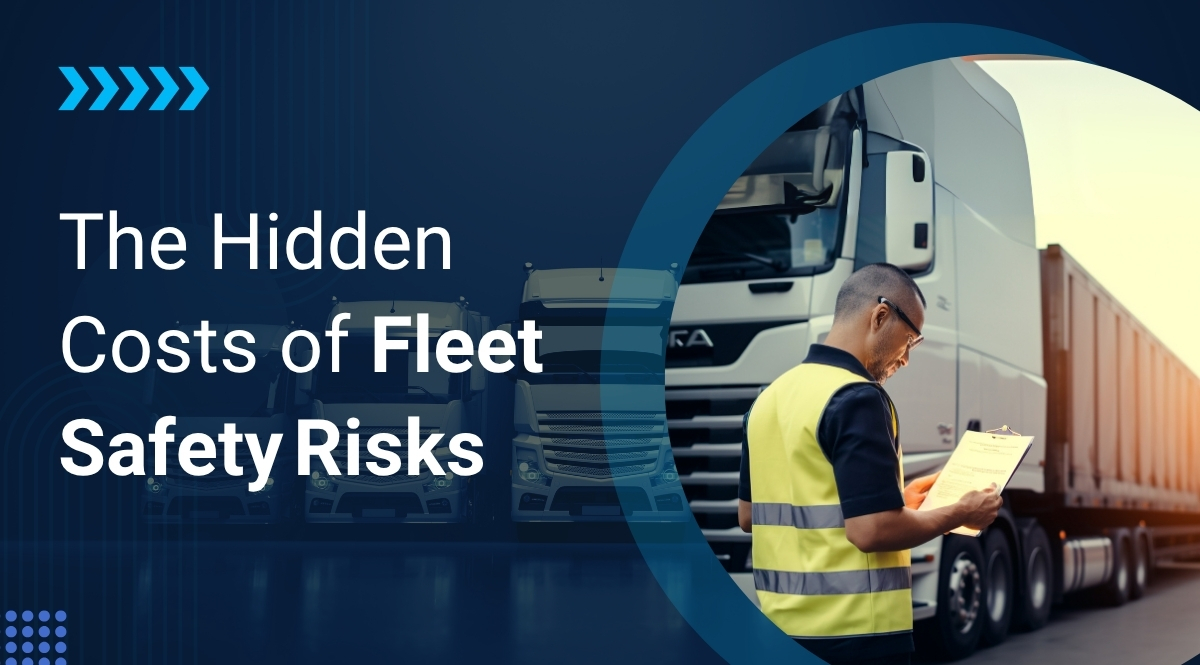Top 10 Safety Metrics Every Fleet Risk Manager Should Track

Increasingly, fleet risk management has become a predominantly data-driven discipline. Dating back to the origin of telematics in the 1970s with GPS satellite technology, risk managers have looked to a plethora of technologies to provide insights into how risks seep into their operations and how to remedy these risks. Emerging breakthroughs in Artificial Intelligence and Machine Learning provide unprecedented opportunities to leverage data to proactively identify hazards, reduce accidents, and improve compliance. Below we break down 10 key fleet safety metrics for commercial vehicle fleets, what they are and why they matter, with industry and official sources highlighting their importance.
1. CSA (Compliance, Safety, Accountability) Scores
What it is:
CSA is the Federal Motor Carrier Safety Administration’s (FMCSA) safety compliance and enforcement program for commercial carriers. Every motor carrier has a CSA score between 0 and 100 which reflects their safety performance across various measures: violations, crashes, and seven Behavioral Analysis and Safety Improvement Categories (BASICs).
High CSA scores indicate a carrier has more safety problems, prompting FMCSA interventions like warning letters, audits, or investigations[1].
Why it matters:
CSA scores are essentially a fleet safety report card. A good CSA score (closer to 0) can lead to tangible benefits – such as fewer DOT audits and lower insurance premiums for the company [2] . Conversely, a poor CSA score (especially above intervention thresholds) will flag a fleet for enforcement action and can damage the company’s reputation and eligibility for certain contracts[1]. In short, CSA scores are a top-level risk indicator that fleet managers must monitor to ensure their operations remain compliant and safe.
2. Harsh Braking Events
What it is:
Harsh braking refers to instances where a driver decelerates very abruptly or with more force than necessary. Telematics accelerometers detect these sudden changes in G-force, which are often a sign of aggressive or unsafe driving behavior[3].
Why it matters:
Harsh braking is a leading indicator of collision risk. While sometimes hard braking is not only unavoidable but a best practice (e.g. to avoid a crash), frequent harsh braking usually indicates tailgating, inattention, or other risky habits behind the wheel. By monitoring and coaching drivers on harsh braking, fleets can encourage safer following distances and smoother driving. In fact, reducing harsh braking events has been shown to lower the risk of crashes and the liability costs associated with them[3]. Many fleets use telematics dashboards to track each driver’s harsh brake frequency, since curbing this behavior helps prevent accidents and reduces wear-and-tear on brakes and tires. Simply put, fewer hard brakes mean a safer, more defensive driving style on the road.

3. Claims Frequency
What it is:
Claims frequency shows how often a fleet has insurance claims, typically arising from crashes or liability incidents. It’s usually measured as the number of claims in a period (or per million miles driven) and is tied to the fleet’s accident rate. Essentially, this metric tracks how frequently the fleet is involved in incidents serious enough to file insurance claims.
Why it matters:
Claims frequency directly measures fleet risk and safety performance – the higher the frequency, the more incidents (and costs) the fleet is experiencing. Many insurance programs set targets for claims frequency per vehicle and monitor progress. A reduction in claims frequency signals fewer accidents are occurring, which not only improves safety but also leads to lower insurance premiums over time[4]. Tracking claims frequency alongside the average claim cost helps fleets identify trends (for example, if a particular terminal or driver group has more incidents) and evaluate the impact of safety initiatives. Ultimately, the goal is to drive claims frequency down through preventive measures – safer driving behaviors, better training, and technology – resulting in fewer collisions and losses.
4. Serious Injury and Fatality (SIF) Exposure
What it is:
SIF exposure measures the risk or occurrence of incidents that result (or could result) in serious injuries or fatalities. Rather than counting all accidents equally, this metric zeroes in on high-severity events, for example, crashes that caused a serious injury/fatality or “near miss” events that had the potential to result in a catastrophic outcome. By assessing SIF exposure, fleet managers can determine how often they are either close to or at the worst-case scenarios.
Why it matters:
Not all accidents are equal. A minor fender-bender and a fatal crash are both “one accident” in simple frequency counts, but they represent vastly different levels of risk. SIF exposure tracking ensures fleet managers focus on preventing the most devastating incidents, not just minor ones. Monitoring the SIF exposure rate allows a company to gauge if its safety program effectively prevents severe incidents and to detect growing risks before more tragedies occur. Many industry leaders supplement standard OSHA-recordable incident rates with a SIF metric for this reason[5]. By investigating high-potential near misses and serious crashes deeply, fleets can implement targeted interventions (such as specialized training or operational changes) to reduce the chances of a fatal or life-altering accident. In summary, SIF exposure is a crucial metric for keeping the ultimate safety goal in view – protecting lives by preventing serious and fatal accidents.
5. Maintenance Lag
What it is:
Maintenance lag refers to delays or backlogs in vehicle maintenance, for instance, vehicles going past their scheduled service intervals, or known mechanical issues not being fixed with urgency. This metric can be expressed as the percentage of on-time vs. overdue maintenance tasks or average days a vehicle is past due for maintenance. Essentially, it captures how proactive the fleet is with maintenance and repairs (with any lag indicating vehicles operating in less-than-optimal condition).
Why it matters:
Poor maintenance is both a cost issue and a significant safety risk. Vehicles with worn brakes, bad tires, or other neglected defects are far more likely to be involved in accidents due to equipment failure. In fact, brake problems alone are a contributing factor in nearly 29% of large truck crashes, according to FMCSA data[6]. Similarly, under-inflated tires or mechanical failures from missed maintenance can lead to blowouts or breakdowns on the road. A small investment in timely upkeep (e.g. fixing brake issues or replacing tires on schedule) directly translates to reduced risk of serious accidents. By minimizing maintenance lag and ensuring vehicles are serviced frequently, fleets can significantly lower the likelihood of crashes caused by equipment failure. A well-maintained fleet is a safer one.
6. Speeding Events
What it is:
Speeding events count the instances of drivers exceeding posted speed limits (often by a defined threshold, i.e. five MPH over posted limits). Telematics log each time a vehicle goes over the limit or triggers an overspeed alert. This metric shows how frequently (and by how much) drivers speed during their trips.
Why it matters:
Speeding is one of the most dangerous driving behaviors, as it greatly increases both the likelihood of a crash and its severity. Higher speeds mean longer stopping distances and more forceful impacts. According to the National Highway Traffic Safety Administration, speeding has been involved in roughly one-third of all motor vehicle fatalities for decades; in 2023 alone, it was a factor in 29% of U.S. traffic deaths[7]. For fleet operators, each speeding incident is a red flag – a driver putting themselves, the vehicle, and others at risk. By tracking speeding events, fleet risk managers can identify patterns and take corrective action through coaching or setting speed governors. Reducing speeding events has a direct payoff: fewer accidents and injuries, and often improved fuel economy and lower vehicle wear as well. Keeping a close eye on speeding behavior is key to cultivating a safety-first driving culture and avoiding the costly consequences of speed-related crashes.
7. Distracted Driving Incidents
What it is:
Distracted driving incidents refer to occurrences when a driver is not paying full attention to the road – commonly due to smartphone use, but also other distractions like eating, reaching for objects, etc. Fleets now use in-cab cameras and sensors that can detect and count distraction events.
Why it matters:
Distracted driving is deadly. Taking eyes off the road for even a few seconds vastly increases crash risk. The statistics are staggering, in 2023 alone, 3,275 people were killed in crashes involving distracted drivers[7]. That means thousands of lives lost due to moments of unfocused driving. For commercial fleets, each distracted driving incident is an impending disaster that almost happened – a truck traveling the length of a football field with a driver not looking, which could easily end in a multi-vehicle pileup. By tracking these incidents, fleet managers can intervene with training or disciplinary action before a tragedy occurs. This metric’s importance is also recognized by regulators and insurers, as distracted driving violations affect CSA scores and liability exposure. Simply put, eliminating driver distraction is a must to reduce crash rates. Fleet risk programs often implement strict “no phone” policies and use AI-driven dashcams to alert drivers (and management) of distraction events, precisely because reducing those events saves lives. Tracking distracted driving incidents and striving for zero helps ensure that drivers remain attentive and that everyone on the road stays safe.
8. Hours-of-Service (HOS) Violations
What it is:
Hours-of-Service violations count any infraction of the federal HOS rules that limit how long commercial drivers can drive and work before resting. This includes driving beyond the allowed hours, skipping required breaks, or falsifying electronic logs. HOS violations are a critical compliance metric (part of CSA scores under the HOS Compliance BASIC) and indicate instances of potential driver fatigue.
Why it matters:
Driving tired can be just as dangerous as driving distracted or impaired. Driver fatigue is a leading factor in large truck crashes – a landmark FMCSA study found that 13% of commercial drivers were fatigued at the time of a serious crash[8]. HOS regulations aim to prevent fatigue-related accidents by ensuring drivers get adequate rest. Therefore, a high number of HOS violations in a fleet is a glaring warning sign: it suggests that drivers may be pushing beyond safe limits and putting themselves and others at risk of fatigue-related crashes. Fleet risk managers track HOS violations not only to avoid hefty fines but to catch dangerous scheduling or dispatch practices that lead to driver exhaustion. By monitoring this metric, fleets can take corrective action (retraining dispatchers, using ELD alerts, etc.) to improve compliance. The payoff is twofold – better compliance means a lower CSA score and less chance of intervention, and well-rested drivers mean a lower risk of catastrophic crashes due to falling asleep at the wheel[8].
9. Preventable Collisions
What it is:
Preventable collisions are accidents that a driver could have reasonably avoided. After any incident, safety teams assess “preventability” – essentially whether the driver did all that a cautious driver could to avoid the crash. If not, the collision is deemed preventable. As a tracking measure, many fleets calculate the number of preventable accidents per million miles or per driver.
Why it matters:
The preventable collision rate is a core safety indicator in fleet operations. It focuses attention on accidents that didn’t have to happen – meaning they could be reduced through improved driver behavior or training. By analyzing each preventable incident, fleet risk managers can conduct a root cause analysis and then coach drivers on those specific issues. The goal is to drive the preventable collision rate down to zero. This metric is also closely watched by insurance underwriters and clients; a high preventable accident rate signals higher risk. On the flip side, demonstrating a low (and decreasing) preventable collision rate can help a fleet negotiate better insurance terms and win business by showcasing a strong safety culture. In practice, tracking preventable incidents helps prioritize safety efforts. For example, if many preventable incidents involve rear-end crashes, the fleet might invest in forward-collision warning systems and following distance training. Over time, success in reducing preventable collisions means fewer crashes, less injuries, and lower costs. As an illustration of potential impact: the US Department of State achieved zero preventable collisions for over a year after implementing a robust driver coaching program[9]. Simply put, every preventable collision avoided is an actual accident prevented – making this metric indispensable for continuous safety improvement.
10. Near-Miss Incidents
What it is:
A near miss is any incident where an accident almost occurred but was narrowly avoided at the last moment. In driving terms, these could be sudden swerves, hard brakes, or other abrupt maneuvers that prevented a collision or injury. No damage or loss happened, yet the situation had the clear potential to result in a crash if one or two factors were different. Many fleets encourage reporting of near misses or use telematics triggers (like collision avoidance systems) to count them. OSHA and safety experts often define near misses as unplanned events that could have led to an accident, even though they didn’t[10].
Why it matters:
A near miss, is the canary in the coal mine for fleet safety. Each near-miss incident is a free warning – an opportunity to learn and fix a hazard before an actual accident happens. Studies in safety management famously suggest that for every serious injury accident, there may be hundreds of prior near misses. In fact, for every one serious truck accident, there are roughly 300 near-miss events, according to OSHA estimates[11]. If a fleet only looks at actual accidents and ignores near misses, they miss the vast majority of at-risk events. By tracking near-miss frequency and circumstances, risk managers can identify recurring hazards and proactively intervene. For example, if multiple near misses involve a particular driver’s lane changes, that driver needs coaching before a real crash occurs. Or if many near misses happen at a certain delivery location, perhaps route adjustments or additional safety measures are needed there. Recognizing and reporting near misses fosters a proactive safety culture – it puts drivers and managers in the mindset of addressing problems when they’re small. Ultimately, the goal is to reduce both near misses and actual collisions in parallel. A high near-miss count is a red flag, but also an opportunity: it gives fleets actionable insights to prevent the “next one” from being a real accident. By treating near misses seriously (e.g. through a formal “good catch” reporting program), fleets can improve safety outcomes and prevent injuries[10].
Concluding Thoughts
In the modern era of fleet safety, what is measured is managed. Tracking these ten risk-focused metrics, from CSA scores and claims frequency to harsh braking and near misses, enables fleet risk managers to spot adverse trends and act decisively. By using reliable data (often collected via telematics, cameras, and safety audits) and referencing industry benchmarks, fleet professionals can prioritize their safety investments where they matter most.
The end result of diligently monitoring these key metrics is a safer fleet, fewer accidents, lower costs, and most importantly, more drivers going home safely each day.
References
- CSA Scores: Everything You Need to Know for Fleet Safety
- CSA Scores: What They Are & Why They Matter
- Halt Hard Braking to Improve Fleet Safety | Geotab
- FNOR: A Crystal Ball for Predicting Fleet Risk
- Safety Commitment | Zero Is Possible | EQT Corporation
- Negligent Maintenance | Why It Matters in a Truck Accident Lawsuit
- Speeding and Aggressive Driving Prevention | NHTSA
- HOS Regulations
- A Human Approach to Vision Zero Initiative
- Why Recognizing Near-Miss Incidents Matters | CRST
- Why Recognizing Near-Miss Incidents Matters | CRST




